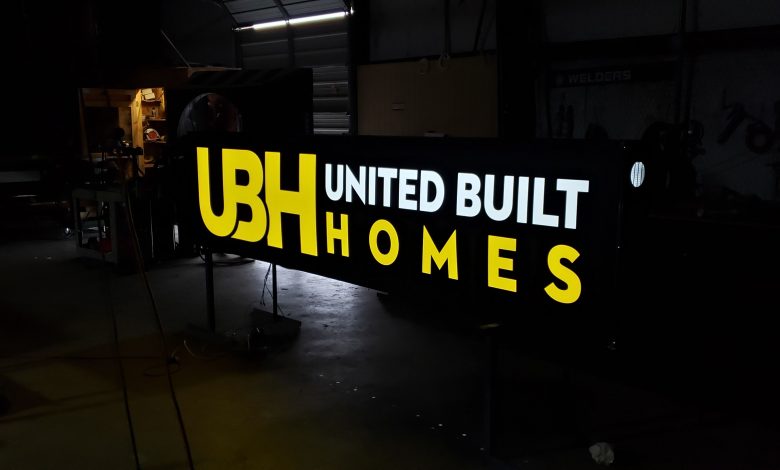Apple co-founder Steve Jobs once said, “I have great respect for incremental improvement … but I’ve always been attracted to the more revolutionary changes.” His outlook lends to the reason why more than 90 million people own an iPhone. To change an industry takes vision, fortitude and execution. It takes knowing what technology is currently in place and building on it to provide a better solution. Change for the better relies on a series of improvements to ultimately trigger revolutionary overhaul. And such a movement has occurred in the sign industry.
Before the LED took over as the most popular option to light a sign, there were bulbs and florescent options. When sign makers — as well as members of other industries — realized the efficiency of LEDs (along with their small size and long life), they began including them in many more projects.
According to Leslie Donels, sales manager at GOQ LED AMERICA, “Lower prices, higher quality and better viewing angles” all contribute to the reason for the rise of LEDs in sign projects. On top of that, LEDs have sparked change in other areas of the industry.
Let’s take a look at some specific advancements that have been made in LED technology, and how sign makers have modernized lighted signage through the years.
Today Versus Yesterday
It’s been documented that LEDs have surpassed other lighting methods in signage as the preferred choice. However, even over the last five years, there have been frequent improvements to LEDs.
“LEDs have continued to improve in efficiency over the past five years,” tells Gray Lankford, distribution sales representative, GENLED Brands. “We’ve also seen color binning yields tighten, allowing the cost to decrease as more of the visibly acceptable product yield can be utilized.”
Haitzs Law has dictated that costs will continue to fall as LED quality increases. This is the number one reason why LEDs are trusted and used more frequently today than ever before.
“Efficacy has increased to a point where LEDs can beat pretty much any other normal lighting technology in terms of lumens per watt,” says Mike Bluhm, director of global product solutions at SloanLED. “This results in lower energy costs, and fixture costs decrease since you need fewer LEDs for the same number of lumens. You can also reduce the heatsink size since you’re generating less heat. Quality of light has steadily improved to where LEDs can rival or outperform most other light sources.”
To add, “less modules are required to light a larger area and less work (is needed) for installation,” explains Donels. This means that sign shops can also save money on labor costs while customers reap the benefits of a high-performance sign.
Bluhm reinforces this concept by sharing that, “The increased efficacy in combination with lenses allow the user to install less product. Less product means less labor cost thus easier to use.”
This “less is more” benefit presents a true cost savings without sacrificing quality.
“As efficiencies have increased, fixtures and modules with lower power and greater lumen output have been designed,” Lankford says. “Therefore, we can have fewer fixtures or modules used in lighting our signs.”
In the past, sign makers were cautious about, not only how many LEDs were used, but also where they were placed. Hot spots and shadows caused problems with uniform illumination and made the sign appear less than professional. Today, high-performance LEDs can make up for poor placement.
“Due to the proliferation of using optics in signage LED products, the exact placement of the product is not as critical as it once was,” explains Bluhm. “Shadows and light separation from sharp corners in signs have been dramatically reduced by these optics which move the light sideways versus straight up.”
Welcoming Change
One of the biggest transformations in LEDs has been the ability to move the light in a way that improves quality, as Bluhm mentioned. It is one improvement that has added value to the entire sign.
“With greater lumens in smaller packages, we are tasked to develop lenses that can maximize each module’s utility by spreading the light wider, continuing to minimize the number of modules required to light a sign,” Lankford says. “The most difficult area for this is in channel letters where we must still account of the bends and turns, limiting the effectiveness of lens technology.”
In the past, sign makers typically adhered to building a channel letter with a five- to six-inch depth. LED advancements have allowed sign makers to create even thinner letters.
“Perimeter lighting and shallow depth lighting allow for less labor on the perimeter lighting and allows sign customers to build their channel letters with a smaller-inch depth,” Donels says.
So, the actual design and layout of a sign project (i.e., a channel letter) is directly impacted by the lighting unit being used.
“Modules with wide beam patterns are better suited for more shallow wide channel letters and box signs,” suggests Lankford. “Modules with narrower or Lambertian beam patterns are suitable for more narrow deep letters and continue to increase the letter brightness as the efficiency of the LEDs increase.”
New applications have popped up due to the advancements in LED technology. Instead of being limited to channel letter or traditional sign box projects, LEDs have branched out to be included in other ways.
“Dye sublimation fabric display cases have become very popular in Europe and we anticipate this application will transition over to North America,” Bluhm begins. “Illuminating a single-sided display case that is 60mm deep is extremely challenging, but perimeter LED lighting solutions have become more readily available. These side-lighting solutions have limitations in that the LEDs with special tight viewing angle optics can only send the light so far across the fabric. Backlighting solutions can accommodate all sizes but require special optics as to not hot spot on the faces.”
Thinking about ways to incorporate LEDs into previously untapped projects will help expand their use while also allowing sign makers to become more creative in their work.
“The dye sub fabric display cases have challenged our layout team in that the fabric substrate is usually a full color digital graphic,” tells Bluhm. “We encourage the user to test our side illuminating products for the appropriate light levels and coverage needed to illuminate properly.”
Power supplies or the LEDs’ “driver” is also an element that has gone through recent changes. The configuration of LEDs in a sign will dictate how a power supply is used.
“In the sign market, universal input power supplies, while not new, are now ubiquitous,” Bluhm shares. “There are also different power supply form factors to fit into any application for pretty much any environmental condition imaginable. Now that LEDs are everywhere, I think power supplies have adapted quickly to fulfill the market needs.”
Just as LEDs have become brighter and better, a transformation in power supplies has also taken place.
“Power supplies are becoming more reliable while also decreasing in size,” Lankford believes. “We are seeing them last longer. After the industry trialed many different versions and brands, we’ve begun to see the cream rise to the top. Those that properly designed and tested their power supplies have stood the test of time.”
With all aspects of an LED sign improving, there is more freedom for sign makers to design a project without limitations. Most often, sign professionals can trust manufacturers to provide dependable products that fit specific needs of their customers.
“There have been a few manufacturers that have supplied the industry with higher wattage units for larger signs,” says Bluhm. “These custom-made power supplies offer the sign companies a single unit that replaces one to three power supplies. The real benefit is in the reduction of time it takes to install the primary wires of one unit versus three.”
On the Horizon
Even with the latest and greatest products on the market, there is always room for improvement. It’s the reason why the iPhone receives regular upgrades and launches with new versions. LEDs will follow that same pattern, giving sign makers ideas for new methods and offering benefits that will improve on older processes.
“Maximizing value means embracing technology,” offers Lankford. “Moving from the low-cost high replacement systems to top-tier products that have proven reliability and overall better long-term returns for the end user. This includes initial cost, long-term reliability savings, and energy savings.”
Specifically, there are areas where sign makers can excel.
“I would always encourage the sign maker to utilize the LED’s guidelines for spacing,” Bluhm points to the LED arrangement. “Not all LED systems are equal and some of the better products out in the market perform two times better than others. In my travels I typically see the over-population of LEDs in a sign. This increases the cost of the sign which of course decreases the profit for the company who made the sign.”
Donels believes there are ways to maximize brightness such as using “a better white, a better ‘pop’ with brightness. If you go cheap in value, the brightness will not be there. GOQ LED offers a Samsung LED that allows a 10,000 kelvin to 11,000 kelvin without the ‘blueing.'”
As far as the actual LED product, manufacturers have taken strides to make important enhancements that add to performance.
“Recently we’ve seen huge jumps in quality of light. A major gripe against LEDs has been that they cannot compete with incandescent or daylight,” shares Bluhm. “I think as a result of LEDs’ shortcomings, lots of studies have been spawned to figure out why certain types of light look good and make us feel good. I think these concerns will evaporate in the next 10 years and ‘full spectrum’ or 95+ CRI (or an even better metric than CRI) will become the norm.”
And that includes areas even outside of the sign industry. LEDs are moving into prominent lighting locations where brightness and dependability are essential.
“LEDs will begin replacing a lot of high-powered light sources,” continues Bluhm. “LEDs just recently got to a place where they can replace car headlights. While they already exist on a smaller scale, in 10 years LEDs will become the norm for spotlighting, stadium lighting, and other high-powered lighting applications.”
In the sign world, however, there are certainly some new advancements on the horizon. In addition to providing the brightest and longest lasting solutions, there is a question about ease of use.
“Increased usage of control systems will be used to identify signage interruptions for quick response troubleshooting,” Lankford says. “Getting signs back into working order with remote resets to maximize the biggest advertising tool for companies. We’ll also see sensors and controls that will continue to add increased energy savings based on the user’s preferences.”
As sign makers select lighting sources for their upcoming projects, they will weigh the pros and cons including costs, quality and versatility. In the end, it appears that LEDs will come out ahead by a large margin.
“I think a lot of lighting technologies are going to disappear,” Bluhm predicts. “As LED costs decrease and efficacy increases, I think fluorescent, metal halide, and HPS will be basically gone in 10 years. LEDs can provide better quality of light at better efficacy, and it will be very soon where cost will not be an issue. At that point it will just be a matter of choosing the LED solution that best fits your application.”





